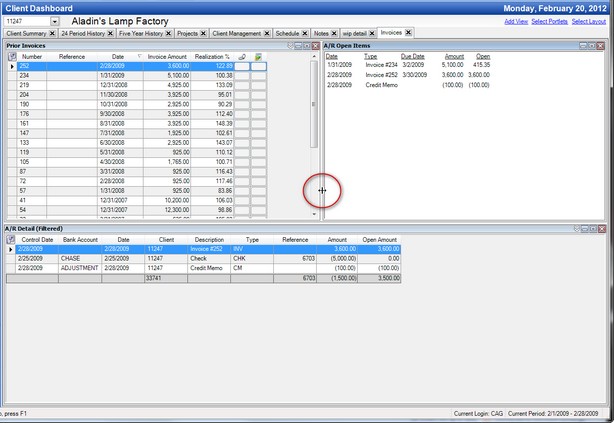Practice CS provides a feature known as dashboards which enables you to view information about virtually all areas of the data in Practice CS in a single, convenient location that each staff member can customize to their specific needs and preferences. There are four dashboards.
- Staff Dashboard: Information about the activity and assignments for the staff member logged in.
- Client Dashboard: Information about the activity and status of a selected client.
- Firm Dashboard: Information about the activity and status of the firm as a whole or a subset of the firm such as the clients associated with an office or partner.
- Home Dashboard: Access to resources outside of Practice CS that can enhance the use of the program such as the Practice CS Library, Practice CS and Thomson Reuters Newsfeeds, and the Help & How-To Center.
Dashboards are made up of three hierarchical components.
- Portlet: A window that contains information
- View: A collection of Portlets on a single screen (each View appears as a tab at the top of the dashboard screen)
- Layout: The collection of Views that make up the Dashboard
Most dashboard layouts consist of many portlets that are organized on several views. The views typically contain portlets that are related to each other such as:
- Projects and Tasks assigned to a staff member (Staff Dashboard)
- A client's WIP and A/R balances, and billing and activity totals (Client Dashboard)
- Schedules, targets, and activity for all staff (Firm Dashboard)
The information below provides instructions for building and modifying your dashboards.
Adding a layout
You do not have to begin with an empty dashboard and build it from scratch. Your Practice CS database comes preloaded with default layouts for each dashboard. Also, other members of your firm may have created a dashboard layout and saved it. You can start with any layout that is in your Practice CS database.
To select a layout, click the Select Layout link in the upper right corner of the dashboard screen.
When you select a layout, the program will ask if you want to save the layout you currently have. If you answer Yes, the system will ask you to give it a name. After doing this, the layout you just saved will be available to you and all other users of Practice CS.
Adding a View (tabbed page)
Views allow you to create a "page" in your dashboard layout in which you can place one or more portlets. Typically, a view will contain portlets related to a specific function or type of information. Each view will be designated as a separate tab at the top of your dashboard screen.
To add a View, click the Add View link in the upper right corner of the dashboard screen. You will be asked to give the view a name.
A new view will be added to the layout that will appear as a blank screen with a tab at the top containing the name you gave the view.
You can now add one or more portlets to the new View
Notes
- To delete a view from the layout, click the
 button in the tab of the view.
button in the tab of the view. - To move the view tab to a different location, click and hold the left mouse button on the view tab and drag it to a different location at the top of the dashboard.
Adding a portlet to a new view
You can add as many portlets as can practically fit on a view. The first portlet added will fill the entire view.
To add the first portlet to a view, click on the Select Portlets link at the top of the screen, or right-click anywhere on the blank screen and choose Select Portlets. The Select Portlets screen opens. You can choose one or more portlets to add to the view by checking the boxes in front of each portlet you want and then click OK.
The Prior Invoices portlet selected above appears in the new Invoices View.
Adding a portlet to an existing view
Once the first portlet has been added, you can add additional portlets by clicking the Select Portlets link and selecting one or more portlets on the Select Portlets window. These portlets will appear on the left side of the view. In the illustration below, the A/R Open Items portlet and A/R Details portlet were selected to add to the Invoices view along with the Prior Invoices portlet.
Moving a portlet on an existing view
After adding one or more portlets, you can move it to a different location on the view. To move the portlet, position the cursor in the header of the portlet you wish to move. Click and hold the left mouse button. Then, drag the pointer to the inside edge of an existing portlet. As you approach one of the inside edges, a shaded area will appear. When the shaded area is approximately where you want to locate the portlet, release the left mouse button and the portlet will move to the shaded location. You can then resize the portlet, if needed, by positioning the cursor over a divider line until it changes to a double facing arrow. Click and hold the left mouse button and move the divider until the portlet is the desired size. Release the mouse button to save the new position of the divider.
In the illustration below, the A/R Detail portlet was moved to be below the Prior Invoices Portlet by moving the mouse to the bottom edge of the Prior Invoices portlet. The A/R Open Items portlet was moved to the right of the Prior Invoices portlet by moving the mouse to the right edge of the Prior Invoices portlet. Finally, the A/R Open Items portlet was made wider by moving the divider line between the Prior Invoices portlet and the a/R Open Items portlet.

Was this article helpful?
Thank you for the feedback!



